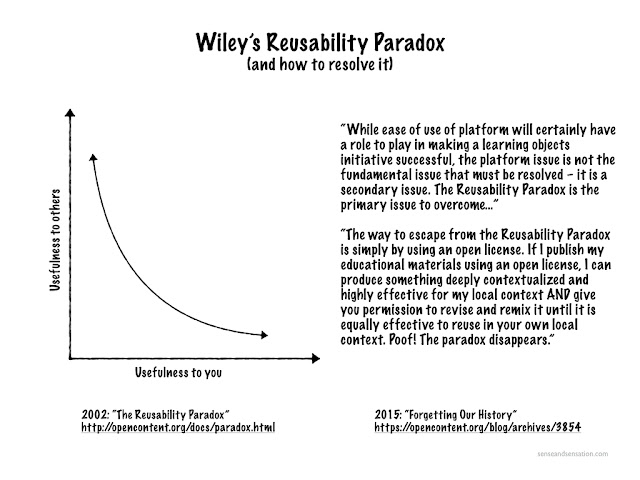Being reminded of the Reusability Paradox (something I had been introduced to a handful of years ago, but had no context for deeply understanding then) might have been one of the most critical components of this course to date for me.
In brief (and in my own words), the Reusability Paradox states that the more useful something is in a given moment in a given classroom, the less useful it is in other moments in other classrooms. The more a question serves a particular purpose for you, the less it will be useful for others. Conversely, the more generally useful something is for everyone, the less useful it is at any given moment. But once you customize it to make it useful in a given moment, the less useful it is to others.
The example of this in my mind has been the discourse surrounding growth mindset. Everyone is excited about growth mindsets. But how is that useful for a math teacher who is teaching how to factor polynomials? In order to make it useful in that context, the math teacher customizes it by saying to a struggling student, "let's try completing the square" or "have we tried all strategies for factoring?" Because these encourage different strategies, they help a math student believe that their intelligence isn't fixed, and that they can improve at math by learning and trying different strategies for factoring polynomials.
But now the particular learning approach/object/experience has been customized to be relevant to math teachers only, and once it is customized with the language of a discipline, the intervention is no longer useful to English teachers, history teachers, language teachers, etc. This is the Reusability Paradox. The more useful something is to you, the less useful it is to someone else.
~
This paradox had been lodged in my mind as something unresolved, and even in my notes from this week’s lecture, I included Wiley’s follow up statement—“The permissions granted by open licenses are the escape hatch from the reusability paradox.”—almost as an afterthought. In the context of this week, the Reusability Paradox arose in discussion briefly, was lightly brushed aside, and then the lecture moved on. The paradox was an accepted fate, and something of a non-issue.
But revisiting notes from old conversations and rooting around in recent blog posts by Audrey Watters (9/2017) and David Wiley (4/2015) led me to the realization that there has been contentious, exasperating, protracted discussion about "learning objects" (usable, portable bits of curriculum) in the context of the Reusability Paradox.
And, it also led me to the rediscovery that the paradox has a solution, and that Wiley's offhand remark about an "escape hatch" is actually quite significant.
So, I created the simple image above—graph and text—as a reminder that the learning object isn’t doomed, but that if it is to be (re)incarnated, it must be done so in a way that is remixable, fully. If we are to share bits of curriculum, we need to be sure that they are customizable, that they are fully open. Without this capability, their usefulness to others is limited. This is crucial.
I wonder if I should be confident in this conclusion, that I can take it as fact, or whether, as Watters cautions, I should dive more deeply to better understand the history of the debate. We have time to only know so much...
~
Upon reflection, I've seen this borne out in my own work on a local sharing platform. We administered a survey to participants in a summer fellowship built around sharing resources. What did they say they were looking for online?
It was clear that our teachers wanted flexibility. They didn't want fixed objects. Reusability comes from being able to tweak other people's practices. They wanted ideas that they can fine tune, or conceptual frames that they can then design within.
And this validates Wiley's "escape hatch." The Reusability Paradox isn't a paradox at all if what matters most is a teacher's ability to edit, revise, tweak, or remix what other teachers have done. The ability to change is all. To adapt. Teachers want to customize for their own settings. They want to design it anew.
And this validates Wiley's "escape hatch." The Reusability Paradox isn't a paradox at all if what matters most is a teacher's ability to edit, revise, tweak, or remix what other teachers have done. The ability to change is all. To adapt. Teachers want to customize for their own settings. They want to design it anew.
It's no wonder. Teaching is the most creative profession I can think of. We are designing experiences every single day, and delivering/performing them (even when we are the guide on the side) every single day. The thrill is as much in preparation and delivery--in the design and execution--as it is in the relationships we form, the learning we structure, and outcomes we foster.
~
Six reflections on open learning and platform technology:
- Learning by Sharing: Why We Do, Sometimes Can't, and Often Don't (Part 1 of 6)
- The Commons: It's the Community (Part 2 of 6)
- Sharing Knowledge and Networks: Synchronous vs Stigmergic (Part 3 of 6)
- Resolving the Reusability Paradox (Part 4 of 6)
- Platform Design: Research Directions (Part 5 of 6)
- Should We Try to Open the Past Before Trying to Open the Future? (Part 6 of 6)


Comments
Post a Comment